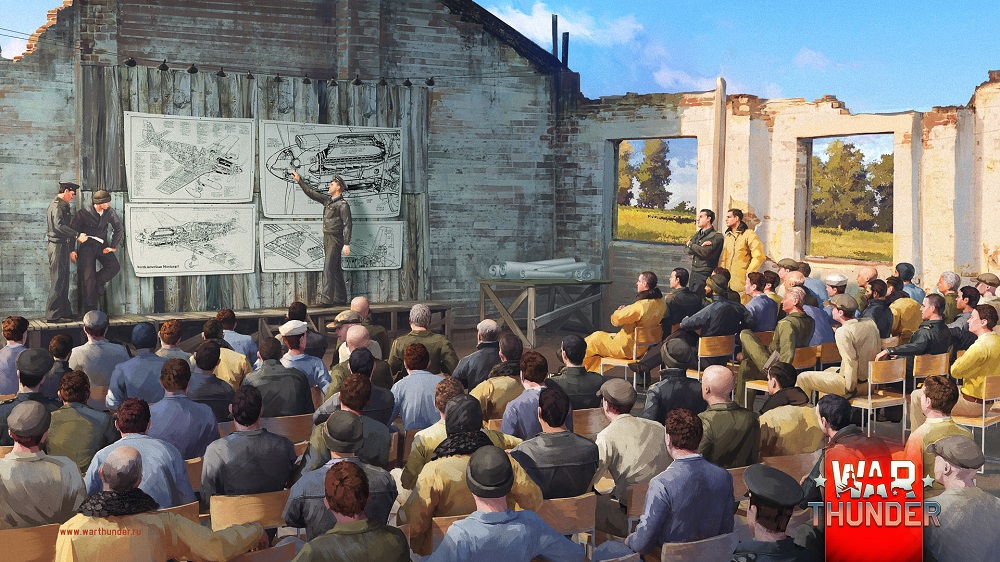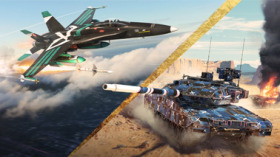
- For PC
- For MAC
- For Linux
- OS: Windows 10 (64 bit)
- Processor: Dual-Core 2.2 GHz
- Memory: 4GB
- Video Card: DirectX 11 level video card: AMD Radeon 77XX / NVIDIA GeForce GTX 660. The minimum supported resolution for the game is 720p.
- Network: Broadband Internet connection
- Hard Drive: 22.1 GB (Minimal client)
- OS: Windows 10/11 (64 bit)
- Processor: Intel Core i5 or Ryzen 5 3600 and better
- Memory: 16 GB and more
- Video Card: DirectX 11 level video card or higher and drivers: Nvidia GeForce 1060 and higher, Radeon RX 570 and higher
- Network: Broadband Internet connection
- Hard Drive: 62.2 GB (Full client)
- OS: Mac OS Big Sur 11.0 or newer
- Processor: Core i5, minimum 2.2GHz (Intel Xeon is not supported)
- Memory: 6 GB
- Video Card: Intel Iris Pro 5200 (Mac), or analog from AMD/Nvidia for Mac. Minimum supported resolution for the game is 720p with Metal support.
- Network: Broadband Internet connection
- Hard Drive: 22.1 GB (Minimal client)
- OS: Mac OS Big Sur 11.0 or newer
- Processor: Core i7 (Intel Xeon is not supported)
- Memory: 8 GB
- Video Card: Radeon Vega II or higher with Metal support.
- Network: Broadband Internet connection
- Hard Drive: 62.2 GB (Full client)
- OS: Most modern 64bit Linux distributions
- Processor: Dual-Core 2.4 GHz
- Memory: 4 GB
- Video Card: NVIDIA 660 with latest proprietary drivers (not older than 6 months) / similar AMD with latest proprietary drivers (not older than 6 months; the minimum supported resolution for the game is 720p) with Vulkan support.
- Network: Broadband Internet connection
- Hard Drive: 22.1 GB (Minimal client)
- OS: Ubuntu 20.04 64bit
- Processor: Intel Core i7
- Memory: 16 GB
- Video Card: NVIDIA 1060 with latest proprietary drivers (not older than 6 months) / similar AMD (Radeon RX 570) with latest proprietary drivers (not older than 6 months) with Vulkan support.
- Network: Broadband Internet connection
- Hard Drive: 62.2 GB (Full client)

Dear Players
Today, we wanted to share some more insight and answers on the recent penetration mechanic changes to explain our plans, goals and some more on your specific questions.
When planning the move to a new method of penetration calculation we set ourselves following goals:
- To make the penetration calculation system open and understandable, in which the method is known and the data for the calculations are known clearly to all. In the old calculation system each shell received its penetration data manually from a variety of sources, ranging from authoritative monographs to documents on firing tests. At the same time, in many of these sources the penetration data was also calculated according to different methods and different standards of states, different targets and with different hardness of armour and shells used. Therefore, uniformity and standardization were out of the question and accordingly it was not the best option in terms of openness and ease of understanding.
- To get rid of the discrepancies that arise from the use of many different sources. When considering data from sources, inconsistencies arise due to different standards and criteria. The problem immediately arises in the reference source - which document is the correct document? However, the sources in question are documentary and credible. The situation is - all are equal, but some of them are more equal. Again, as you can see, this was not the best option.
- Focus the attention when setting up armour-piercing on their input parameters - mass, speed and speed drop tables. If you have a shooting table for the shell, you can more accurately model its behavior and, first of all, its penetration. We will not stop working with documented sources. We collect information scattered over hundreds of conflicting sources and concentrate it on firing tables and ammunition ballistics settings.
- To streamline the armour-piercing system in the game. Manual entry of penetration data, from sources, in some cases created situations where the data in the shell cards were from documents in which the penetration data were based on very different criteria. Which is not the norm. With the increase in the number of vehicles in the game, and therefore the number of ammunition, the sources of information regarding the penetration values are beginning to exceed reasonable limits, and some documents are not publicly available and could no longer be open and easy to understand.
We definitely have not stopped working with documented sources. The specified method of calculation is to work with documents first of all, and more purposefully and effectively, allowing us to specify not only the penetration data, but also ballistics of shells, thus allowing us to standardize all this information in game.
Now, lets move on to the Q & A:
Q.Will primary source material if it contradicts the calculated performance, still be taken into any consideration for the newly calculated APFSDS rounds? For example, Swedish tests show vertical performance of DM33 and it is substantially higher than calculated values.
A. In the calculation we used the density of tungsten cores equal to 17500 kg/m^3 (indicated in the published table sheet with changes). This corresponds to the 2nd class of tungsten alloy from the specification. The choice of this density value has been made due to the fact that the exact density values at the moment are unknown for us. In this case if reliable and unambiguous (based on documents, shooting reports, etc.) information about the density of cores is provided, we are ready to clarify it for the appropriate ammunition. Until such data is available we are fully satisfied with the current data scores for the ammunition.
Q. If there are armour values on tanks that are based on what rounds can and cannot penetrate them (both by design specification and performance in combat), will we see armour changes where appropriate?.
A. No, such changes would contradict the goals we set when developing this method. There are no plans to introduce an additional indicator of the quality of the armour, except for what is already in the game.
Q. Will the Demarre equation that is being used be fixed? A fair amount of apcbc rounds would be over performing (much higher than historic data) if we used the current calculation from the wiki.
A. By choosing the method we knew that there would be some discrepancies, both in the smaller and in the larger direction. And after the evaluation of possible negatives and positives we decided that the general level of changes in values is comfortable for us by not exceeding the level of conditionality that had already been before. It makes many more improvements and last but not least it reveals the method of penetration calculation for everyone and makes it clear. Therefore, there are no plans to make any corrections to the calculation aimed at "fitting" the data to various sources.
Q. The Slope modifier equations from World War 2 Ballistics: Armor and Gunnery, were designed to work with the vertical penetration values from the book. Changing these values while also changing the vertical penetration of many projectiles, many lower, and some higher, will cause issues. How is this going to be handled?
A. We do not want and will not allow situations that violate the integrity of the selected calculation method. Using the calculated values of slopes together with the old method of choosing armour-piercing will be just such a situation.
Q. The DeMarre formula relies on an empirically derived constant. This constant differs based on armour-projectile combination. How do you plan to determine this constant given the vast array of armour and projectile types in the game?
A. Earlier in the game as previously indicated the penetration values were given for armour of low hardness. The constant for the calculation has been chosen so as to also correspond to this armour. This value is 1900 and corresponds to the homogeneous armour of low hardness.
Q. Does standardizing penetration performance of ammunition also allow for standardizing secondary fragmentation for ammunition? Right now all rounds that utilize the 'long_rod' shatter preset create less fragmentation than rounds with less weight, thickness and velocity. This is also noticable on APDS, where an APDS round with a comparable penetrator diameter to an AP round creates much less fragments.
A. The applied calculation method of armour-piercing data acquisition is not connected with secondary fragments configuration. This problem is known and will be corrected.
Q. Will ricochet angles for long rod penetrators receive a change? Pre change they are a fixed angle across many different shells with different velocities and tip designs, the target material is also not taken into account when in reality this has a big effect and can change the ricochet angle by a great deal.
A. Revision of ricochet values for APFSDS shells was not planned in the near future. If and when the reliable information will be provided to improve and refine the ricochet parameters (if necessary) for these shells, it will be considered in the usual order.
The War Thunder Team




Comments (121)
This is no Q&A, this is Gaijin telling us how is it going to be, regardless of opinions.
What about br fixes? Some tanks are facing heat fs tanks mainly german and soviet ww2 heavies
something like the IS4m should face heat-fs otherwise it's immortal to many normal rounds. that's balance my friend
scorplion, he said ww2 heavies
This is pathetic.
You don't have any document for the tungsten alloy density, so you "rightfully" put 17500kg/m^3, which is very low and causes the DM23 to be basically worse than DM13... fair enough...
keep in mind the natural tungsten density is at 19300kg/m^3
chrkiiler, It's an alloy, ofc it won't have the same density as pure tungsten. That said, DM23 was around 18100, while the DM33 was around 18500-18600. That's pretty well known, but Gaijin wouldn't be Gaijin if they didn't screw Germany over. Leo 2A4 still does not have its Trunnion or the spaced side armor instead of those laughable 10mm Gaijiggle give them.
When Linux version will get a update? The actually version work so bad using OpenGL 3.3
Our devs are working on a new API to replace OpenGL 3.3 for some time, but it's not ready to go live yet (performances looks pretty good, but there are technical issues that need to get ironed out)
"questions and answers from the developers", yep, questions and answers from the developers ;) Working as intended since 2013 comrad
Thanks for admitting that the main reason for adding this system is that you just want to add new more modern vehicles that are fully classified and have no publicly available documentation "and some documents are not publicly available." This Q and A is still just trying to shove these incorrect formulas down our throats. The equations are being applied to rounds they were never meant to represent ie Russian slug apfsds being represented by a long rod formula, and shell shape is ignored.
Update 1.89 "End Game" When the game will be completely unfair and only russian APFSDS will penetrate. Abrams don't pen anymore,Typy 90 is trash now,Leopards are trash,Air Realistic battles are disappoiting now,repairs are high,grinding is even harder,make 7 kills but match ends in 5 minutes= shitty RP.
How sad. This Q&A tells "our formula is perfect, deal with it". Big thumbs down from me.
You dont trust the penetration-values on paper, but you trust the velocity of the rounds? if they lied on the pen, they lied on the speed. and with that, your calculation is worthless... worthless like your next updates because people are leaving this game because you again ignore the community.
Submit a complaint